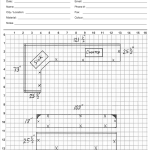Countertop Measuring Process
When you’re taking your measurements start by making a drawing of what you’re measuring.
Begin with the overall size and shape, then add details, like cutouts, walls and finished edges, if in doubt, too much information is better than not enough. You can print a sheet to make it easier here.
Once your drawing is complete, take your measurements and write them on the drawing in a way that makes it clear what each number means. Rounding up your measurements is a good idea in the initial planning stages.
Your process will be slightly different if you’re measuring existing countertops or bare cabinets. It is much easier to measure bare cabinets.
Existing Countertop:
Step A – Measuring Length: measure along the wall from one edge to the opposite edge.
Step B – Measuring Width: measure from the back wall to the finished front edge.
Step C – Measuring Overhang. Measure from the finished front edge to the cabinet edge behind and below. Make sure to measure the distance to the cabinet and not a door or drawer front. Measure the overhang for all finished edges.
* If your existing countertop has a backsplash, be sure to measure the thickness and note it on the plan.
New Cabinetry:
Step A – Measuring Length: Measure along the wall from one edge to the opposite edge.
Step B – Measuring Width – Measure from the back wall to the front of the cabinet.
Step C – Calculate overhang: Door/Drawer Thickness+ Hardware Depth +1/8″
Measure it all again. Measure twice and cut once is a motto we live by. Its surprisingly easy to misread or miswrite a measurement, this can be a mistake, adding cost to your project or delaying its completion.
Indicate the location of finished edges using an “X” or “C” or “Finished”
Your drawing should look something like this: 
Send the drawing to us for a quote on your project. If we’re installing for you, we’ll come out for a detailed measurement and in home consultation, so its ok if you’re drawing is a bit off, we’ll make it right before your project is installed.
Countertop Measuring Tips
When measuring its a common practice to ensure that your countertop overhangs the cabinet to cover the doors and door hardware below. 1½” (4 cm) beyond the cabinet front or about 3/4″ (2 cm) beyond the cabinet doors is a common overhang.
Measure your cabinets and add your overhang to find your final countertop dimension. We recommend at least a 1/8” (3mm) overhang to allow for the expansion and contraction of the cabinets and for cabinet angles that maybe slightly greater than or less than 90 degrees.
Make sure that your sink and all faucet fittings will fit in your sink cabinet with adequate clearance for operating the faucet handles. Many homeowners overlook this and have the added time and expense of finding a suitable sink after the countertop measuring process has begun.
If you are not sure, give us a call and we’ll help you out If you’re planning to purchase a made to measure supply-only countertop, and your project includes a section between walls, be sure to let us know, or to compensate your measurements for expansion and contraction. You can print a planning sheet here to help you take your measurments.
…
Find more helpful tips on our Planning Page
